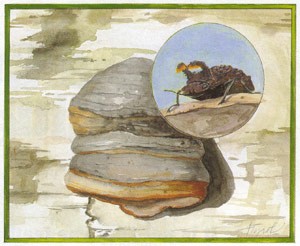
The fruiting structures of the tinder polypore are not hard to recognize, especially if you can remember that it has another common name, which is “hoof fungus.” Shaped like a horse’s hoof, its outer surface is gray or gray-brown and smooth except when marked by the occasional wrinkle and horizontal lines laid down each year as the fungus resumes growth in the spring. The hoofs are nearly black when old or dead. Polypores produce spores on the inside of minute pores, instead of on the more familiar gills that are found on most mushrooms in the grocery store. In much of the forest in the Northeast, they are most common on dead and dying birches, beech, and maples, but in other parts of its circumpolar range, the tinder polypore colonizes many other hardwoods as well.
Each year, a tinder polypore hoof gets a little wider and deeper as a new layer of minute, pore-producing tubes grows on the bottom surface. Sometimes lasting for more than 10 years, these polypores are hard and dense, especially the outside layer, which is built to withstand all kinds of weather. A sizeable perennial structure such as this represents a considerable investment for a fungus, but, on the plus side, having a ready-to-go surface allows it to produce its copious spores early, in April and May, as it doesn’t have to create an entire mushroom in order to deploy spores – just a new layer of pores.
These fungal conks provide both food and housing for a fascinating beetle, the forked fungus beetle (Bolitotherus cornutus), which curls up its legs and feigns death if disturbed. When its extremities are tucked in, it looks exactly like a quarter-inch-long, ratty bit of fungus; its surface is very bumpy, and year-round it appears to have an irregular coating of brown spores.
The forked fungus beetle is relatively easy to find, especially on deteriorating old tinder polypores, which can be pecked apart with a small knife. A hand lens or a microscope will allow you to appreciate the convoluted sculpting of the beetle’s wings and body. These very convolutions may be how the beetle pays the rent. Although both adults and larvae eat the fungus, the adults – who live for several years – disperse the spores that fill their many crevices when they go wandering.
Restricted to the tinder polypore and a couple of other species of fungus, the beetle lives in a naturally fragmented system. The increasing unnatural fragmentation of forests has many people worried about insects and fungi that don’t travel well, and this beetle provides a good subject for study. From the perspective of a small beetle, tinder polypores are tiny islands in a vast sea. Although it has well-developed wings, it has never been seen flying when it seeks to find a new polypore after its old host fungus has crumbled. Nonetheless, marked beetles have been recaptured at well beyond the 42 feet per day that they can cover on foot. When no one is looking, perhaps these lumps of fungus do fly in search of their next home and larder.
The tinder polypore is a heart rot fungus, a relatively non-aggressive type that is unable to infect freshly wounded sapwood. Sapwood has living cells that can fight back. To get a foothold, this fungus depends on finding exposed heartwood, which, being composed of dead cells, is unable to mount a significant defense. Its spread through heartwood is typically slow but relentless. In live trees, it may finally move into sapwood that has been degraded by other fungi or by bacteria. The tree topples or dies upright when sapwood is killed faster than the tree can create it. By the time the visible fungal conks appear, little sound wood remains. There are other, quite similar polypore fungi.
When pioneer species, like paper birches, die, saplings of more shade-tolerant species such as sugar maple often take advantage of the space and ascend into the canopy. From an ecological point of view, the tinder polypore is playing a useful and respectable role. When it infects more valuable, longer-lived trees, the economic cost is sometimes harder to overlook.
Independent of its profession of decomposing trees, the tinder polypore has had a long association with humans. As suggested by the name, the dried interior layers can be used to start fires. This may be why the 5,300-year-old Neolithic “Iceman,” whose body was revealed by the melting of an alpine glacier near the border of Italy and Austria and found in 1991, was carrying it in a pouch, along with several flint stones.
Or maybe he was carrying it for its antibacterial properties, since an autopsy found intestinal pathogens in Iceman, and perhaps he had faith in its healing powers. Historically, the tinder polypore has been used to treat a wide array of ailments, used in making pincushions, and is especially good at banishing evil spirits because it produces a lot of smoke as it burns.


Discussion *